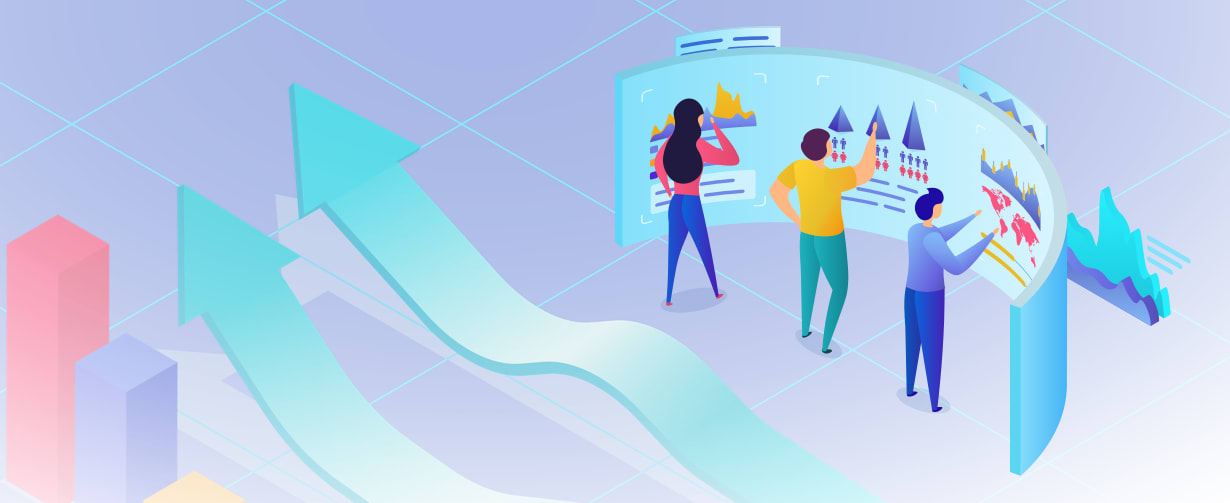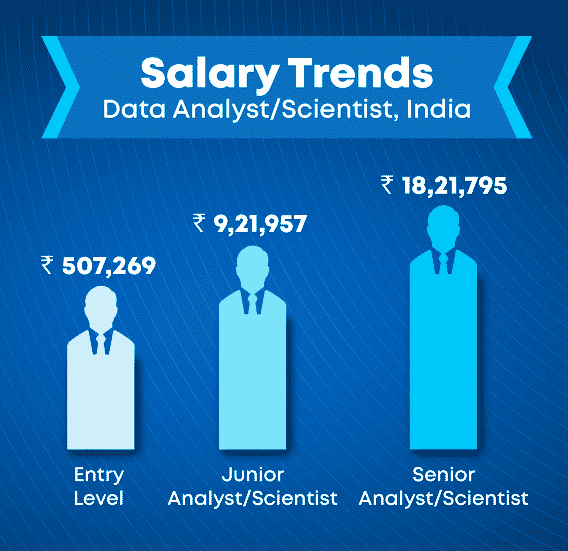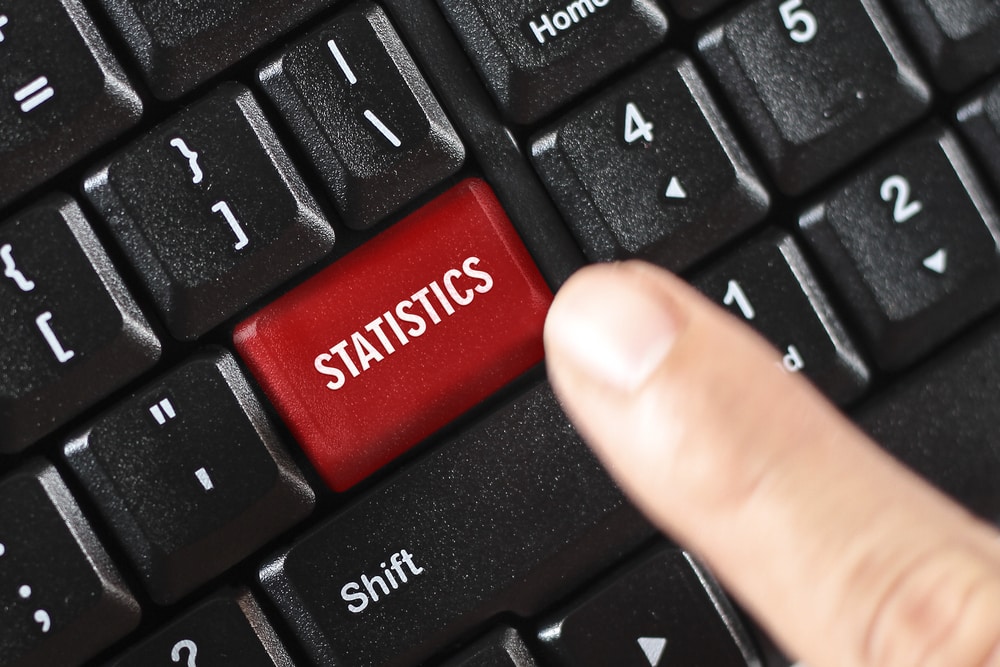- Who is a Data Analyst
- How to become a Data Analyst?
- Important Tools used by Data Analysts
- Data Analyst Roles and Responsibilities
- Types of Data Analytics
- A Day in the Life of a Data Analyst
- Data Analysts vs. Data Scientists
- Data Analyst Salary Trends
- Salaries Based on Roles
- Salaries Based on Industry
- Data Analyst Salary based on Location
Data Analysts are in high demand across various industries. Through the course of this blog, we’ll learn more about the salary of Data Analyst in India, their job description, and what a typical day in the life of a data analyst may look like.
Let’s get started!
- Who is a Data Analyst?
– Job Description - How to become a Data Analyst
– Skills Required
– Important tools used - Data Analyst Roles and Responsibilities
- Types of Data Analytics
- A Day in the Life of a Data Analyst
- Data Analysts Versus Data Scientists
- Data Analyst: Salary Trends
– Overview
– Salaries based on Roles
– Salaries based on Industry
– Data Analyst Salary based on Location
Who is a Data Analyst
Data Analyst Job Description
A Data Analyst, by definition, is a person who collects and evaluates data on sales numbers, market research, logistics, and other such behaviors. They essentially bring technical expertise into the organization to ensure the quality and accuracy of that data. They then process it, design it, and present it in ways to help people and businesses make better decisions.
Data Analytical jobs, by description, include gathering and cleaning data in order to uncover trends and business insights. However, a day-to-day job of a data analyst tends to vary depending upon various factors. This can be the industry, the company, or the specialty of data analytics considered. Most often, data analysts coordinate with IT teams, management, and data scientists in order to determine their organizational goals.
Data analysts are responsible for various tasks and duties; right fromcreating dashboards and programming to designing databases and utilizing intelligent software, they play a vital role in different departments throughout their organization. Most often, they pinpoint important trends, correlations as well as patterns in complex data sets to identify new opportunities for improvement.
Read more on What is Data Science?
How to become a Data Analyst?
Considering data science to be a vast domain, it is essential for an analyst to have a versatile skill set in their profile. There are several paths to becoming a Data Analyst, however, in general, a set of specific skills and tools can aid well in the process.
Skills Required to become a Data Analyst
- Programming Languages (R/SAS): It is essential that data analysts are proficient in at least one language and have good knowledge in the working of a few more. Programming languages such as R or SAS are used by data analysts to gather clean data for statistical analysis, and data visualization.
- Creative and Analytical Thinking: Creative and analytical thinking are key attributes of a good data analyst. While it is vital to have a strong background in statistical methods, it is also extremely important to be able to think critically through problems with a creative and analytical lens.
- Effective Communication: Communication skills always prove to be an advantage — whether it is for an audience or a team of executives making business decisions.
- Data Visualization: While effective data visualization takes trial and error, to be successful as a data analyst, it is important to understand how to visualise data for best outcomes.
- SQL Databases: SQL databases are essentially a set of relational databases with structured data. Here, data is stored in tables and an analyst will pull information from different tables in order to perform analysis.
- Database Querying Languages: A popular querying language used by data analysts is SQL. There are variations of this language that exist, it includes PostreSQL, T-SQL, PL/SQL (Procedural Language/SQL) from many others.
- Data Mining, Cleaning and Munging: When data has not been neatly stored in a database, data analysts use other tools in order to gather unstructured data.
- Advanced Microsoft Excel: Having a good handle on excel and advanced analytics techniques will only prove to be helpful for a successful Data analyst.
- Machine Learning: Although it is not a specific demand, Data analysts with machine learning skills are considered to be incredibly valuable.
Also read: Critical Skill Sets that make a Data Scientist

Important Tools used by Data Analysts
- Google Analytics (GA): GA is an essential tool that helps analysts in gaining an understanding of customer data and trends that need improvement on landing pages or calls to action (CTAs).
- Tableau: Tableau is highly used by analysts to aggregate and analyze data. It allows them to create and share dashboards with different team members.
- Jupyter Notebook system: Jupyter notebooks simplify the work of data analysts when it comes to testing code. Usually, non-technical people prefer the simple design of jupyter notebooks due to its easy interface and features.
- Github: Github is a platform to share and build technical projects. It is a must for any data analysts to work with this tool, especially for object-oriented programming.
Data Analyst Roles and Responsibilities
Let’s talk about the roles and responsibilities of a data analyst:
- To create and manage the database and data systems
- To define goals and data assets required for a business
- Working on digging out data from various qualifies sources
- Interpreting data for various parties such as clients, owners, and other stakeholders
- To enhance and update the reporting systems
- To develop different data mapping techniques for intricate business inquiries
- Conducting an analysis of consumer behaviour based on latest trends
- Devising a suitable methodology and process to derive a positive outcome
Types of Data Analytics
Breaking down data analytics revolves around answering questions and making decisions. Just like there are different types of questions, there also exist different types of data analytics. While there is no specific set-in-stone glossary of these types of data analytics, ScienceSoft breaks it down into four primary areas:
- Descriptive analytics answers – What happened?
- Diagnostic analytics answers – Why did something happen?
- Predictive analytics answers – What is likely to happen?
- Prescriptive analytics answers – What action should be taken?
Based on what an analyst is trying to accomplish, they can tailor their work to fit into the scenario.
A Day in the Life of a Data Analyst
The day-to-day functions tend to differ at various levels, based on the role, title or industry, However, a generic day of a data analyst involves:
- Checking emails and maintaining dashboards.
- Demonstrating and deep driving technical expertise in solving real world retail problems.
- Collaborating with team members both within and outside the data science team to create and deliver quality output.
- Acting as an SME on the floor to help in building data science capabilities
- Preparation of monthly, weekly or bi-weekly plans by prioritising requests from managers, partners and clients.
- Translating data into actionable insights.
- Creating reports of unique trends or patterns.
- Identifying areas of opportunity to automate and scale ad-hoc analyses.
Also read: Step-by-Step Guide to Becoming a Data Scientist
Data Analysts vs. Data Scientists
Another prominent role in the field of Data Sciences is that of a Data Scientist. While it is safe to say that there exists a certain overlap between the two, there are significant differences between data analysts and data scientists. Based on skills and job duties, here are a few major differences between them:
Data Analysts
- Have moderate mathematical, statistical and coding skills
- Have a strong business acumen
- Create visualisations and analysations data
- Utilise business intelligence to achieve their goals
Data Scientists
- Have extremely strong mathematical, statistical and coding skills
- Help in identification of trends with machine learning
- Make predictions based on data trends
- Write codes for the assistance of data analysis

The roles of both data analysts and scientists are very closely integrated with each other, however, their strengths and responsibilities tend to change depending on the organization.
Data Analyst Salary Trends
Before applying to jobs, the most commonly looked at factor is the salaries associated with it. Salaries in this field tend to vary based on roles, skills, locations, and numerous other characteristics.
Here are some points to note for Data Analyst/Scientist job trends in India:
- India contributes to 6% of job openings worldwide, in this field.
- The total number of data science and analytics jobs in India is equivalent to 97,000.
- 97% of the jobs are on a full time basis and 3% of them are on part-time basis.
- There has been an increase of 45% of the total jobs in this sphere since 2018.
According to PayScale.com the yearly average salary of a data analyst or a data scientist in India is Rs. 818,099. According to further statistics, their average bonus is a total of Rs. 100,473 and their average profit sharing is Rs 36,667.
Salaries Based on Roles
Entry Level Salary in Data Analyst
An average entry Level Data Analyst/Scientist in India can make around Rs 507,269 annually. This essentially includes starters with little background and skill. However, by continuously evolving with the progression of jobs, their salary graph has an upward scale.
Junior Level Salary in Data Analysts/Scientists
Junior Data Analysts/Scientists with experience of at least 2 years in the field earn an average salary of Rs 9,21,957 annually.
Senior Level Salary in Data Analyst/Scientist
A Senior Data Analyst/Scientist with a considerable amount of experience earns an average salary of Rs. 18,21,795 in India.

Salaries Based on Industry
The industry of employment plays an essential role in impacting the salaries of Data analysts and scientists. Here is a table that portrays the kind of salaries earned by Data analysts and scientists in different industries.
| Industry | Annual Salary in Rs. |
| Consumer Goods | 1.3 M |
| Finance | 1.2 M |
| Energy and Mining | 1.2 M |
| Media and Communications | 1 M |
| Corporate Services | 1 M |
Looking to find a data analyst job in the US? Learn about Which Industries Pay the Highest Data Analyst Salary in the U.S.? and upskill today.
Data Analyst Salary based on Location
Depending on where you are situated, your data analyst salary may vary. There are certain cities that may offer a higher salary when compared to other locations in the country.
If you are working in Bangalore, Karnataka, as a data analyst, you may earn an average of 18.7% more than the national average salary. A data analyst in Gurgaon, Haryana may earn 6.7% more than the national average and 3.8% more than the national average in Pune, Maharashtra. The lowest data analyst salary in India may be found in Mumbai. It is 7.7% lesser than the national average salary. And 7.2% less in Chennai when compared to 6.2% less in New Delhi, according to payscale.
If you are situated in the United States, here are the salaries in a few of the major locations according to Robert Half.
- Washington, DC: $141,645
- San Francisco: $151,230
- New York: $149,633
- Chicago: $132,060
- Phoenix: $125,670
- Boston: $142,710
If you are someone looking to get into this field, with the current salary trends and demand for the subject, now would be the right time to up-skill and take advantage of the Data Science career opportunities that exist today. Explore a career in Data Science. You can also refer to the Top 50+ Data Analyst Interview Questions & Answers and enhance your knowledge before any upcoming interviews.









